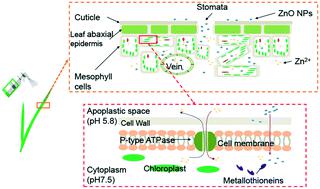当前位置:
X-MOL 学术
›
Environ. Sci.: Nano
›
论文详情
Our official English website, www.x-mol.net, welcomes your feedback! (Note: you will need to create a separate account there.)
Mechanism of zinc oxide nanoparticle entry into wheat seedling leaves
Environmental Science: Nano ( IF 7.3 ) Pub Date : 2020-10-27 , DOI: 10.1039/d0en00658k Jiahui Zhu 1, 2, 3, 4, 5 , Jinfeng Li 1, 2, 3 , Yu Shen 1, 2, 3, 6, 7 , Shiqi Liu 1, 2, 3 , Nengde Zeng 1, 2, 3 , Xinhua Zhan 1, 2, 3 , Jason C. White 6, 7, 8, 9 , Jorge Gardea-Torresdey 9, 10, 11, 12 , Baoshan Xing 4, 5, 9, 13
Environmental Science: Nano ( IF 7.3 ) Pub Date : 2020-10-27 , DOI: 10.1039/d0en00658k Jiahui Zhu 1, 2, 3, 4, 5 , Jinfeng Li 1, 2, 3 , Yu Shen 1, 2, 3, 6, 7 , Shiqi Liu 1, 2, 3 , Nengde Zeng 1, 2, 3 , Xinhua Zhan 1, 2, 3 , Jason C. White 6, 7, 8, 9 , Jorge Gardea-Torresdey 9, 10, 11, 12 , Baoshan Xing 4, 5, 9, 13
Affiliation

|
Nanoparticles (NPs) are increasingly used as agrochemical components through foliar spraying such as foliage fertilizers or pesticides. However, the understanding of the mechanisms of nanoparticle absorption and translocation from the leaf surface is limited. In this study, ZnO NPs (30 nm) labeled with fluorescein isothiocyanate (FITC) were foliar applied to wheat leaf tissues to investigate the process of attachment and absorption. Using laser confocal microscopy, we observed that FITC–ZnO NPs cross the leaf epidermis through the stomata and accumulate first in the apoplast, followed by subsequent transport to mesophyll cells. The Zn concentrations in wheat leaf apoplast and cytoplasm decreased by 33.2% and 8.3% with stomatal aperture diameter reduction, respectively; the apoplastic Zn concentration is influenced more by stomatal aperture than the cytoplasmic Zn level. Scanning electron microscopy with energy-dispersive X-ray analysis was used to map Zn in the wheat leaves and data suggest a different Zn distribution for ZnO NPs and ZnSO4. Zn ions in ZnO NP-treated samples are heterogeneously distributed in comparison with those in ZnSO4-treated samples. The results indicate that the main route to cross the wheat leaf epidermis for ZnO NPs is via the stomata; then these nanoparticles accumulate and release Zn ions in the apoplast, and the released Zn ions and ZnO NPs are absorbed by mesophyll cells. Our findings demonstrate how ZnO NPs cross the wheat leaf epidermis, distribute within mesophyll tissues, and enter into plant cells, and this information is useful for the development of sustainable nano-enabled platforms for nanoscale micronutrient delivery.
中文翻译:

氧化锌纳米粒子进入小麦幼苗叶片的机理
通过叶面喷洒,例如叶面肥料或杀虫剂,纳米颗粒(NPs)越来越多地用作农业化学成分。然而,对纳米颗粒从叶表面吸收和转运的机理的理解是有限的。在这项研究中,将标记有异硫氰酸荧光素(FITC)的ZnO NP(30 nm)叶面施用于小麦叶片组织,以研究其附着和吸收过程。使用激光共聚焦显微镜,我们观察到FITC-ZnO NPs通过气孔穿过叶表皮,先在质外体中积累,然后再转运到叶肉细胞中。随着气孔孔径的减小,小麦叶片质外体和细胞质中的锌含量分别降低了33.2%和8.3%;气孔孔径对细胞质外锌浓度的影响大于细胞质锌水平。扫描电子显微镜用能量色散X射线分析法绘制了小麦叶片中的锌图,数据表明ZnO NPs和ZnSO的锌分布不同4。与ZnSO 4处理的样品相比,ZnO NP处理的样品中的Zn离子分布不均。结果表明,ZnO NPs通过小麦叶片表皮的主要途径是通过气孔。然后这些纳米粒子在质外体中积累并释放Zn离子,释放的Zn离子和ZnO NPs被叶肉细胞吸收。我们的发现证明了ZnO NPs如何穿过小麦的叶表皮,分布在叶肉组织内并进入植物细胞,并且该信息对于开发可持续的,支持纳米级微量营养素输送的纳米平台很有用。
更新日期:2020-11-12
中文翻译:

氧化锌纳米粒子进入小麦幼苗叶片的机理
通过叶面喷洒,例如叶面肥料或杀虫剂,纳米颗粒(NPs)越来越多地用作农业化学成分。然而,对纳米颗粒从叶表面吸收和转运的机理的理解是有限的。在这项研究中,将标记有异硫氰酸荧光素(FITC)的ZnO NP(30 nm)叶面施用于小麦叶片组织,以研究其附着和吸收过程。使用激光共聚焦显微镜,我们观察到FITC-ZnO NPs通过气孔穿过叶表皮,先在质外体中积累,然后再转运到叶肉细胞中。随着气孔孔径的减小,小麦叶片质外体和细胞质中的锌含量分别降低了33.2%和8.3%;气孔孔径对细胞质外锌浓度的影响大于细胞质锌水平。扫描电子显微镜用能量色散X射线分析法绘制了小麦叶片中的锌图,数据表明ZnO NPs和ZnSO的锌分布不同4。与ZnSO 4处理的样品相比,ZnO NP处理的样品中的Zn离子分布不均。结果表明,ZnO NPs通过小麦叶片表皮的主要途径是通过气孔。然后这些纳米粒子在质外体中积累并释放Zn离子,释放的Zn离子和ZnO NPs被叶肉细胞吸收。我们的发现证明了ZnO NPs如何穿过小麦的叶表皮,分布在叶肉组织内并进入植物细胞,并且该信息对于开发可持续的,支持纳米级微量营养素输送的纳米平台很有用。



























 京公网安备 11010802027423号
京公网安备 11010802027423号